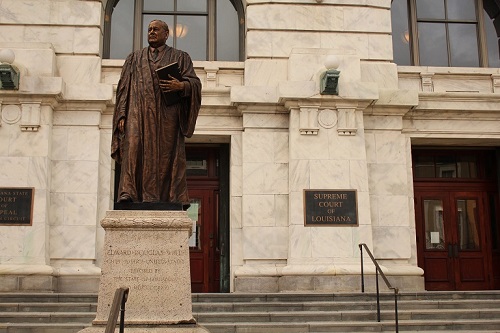Guest column by Okyeame Haley
On Saturday, Jan 2., in true pandemic fashion, admirers of Chief Justice Bernette Joshua Johnson drove around the Louisiana Supreme Court building in New Orleans’ French Quarter to honor her retirement as the first African-American woman on the Louisiana Supreme Court and the first African-American chief justice. I was happy that the pictures and videos of the judge’s celebration didn’t include the gaze of white terror represented by the large and often vandalized statue of Edward Douglass White Jr., a Louisianian who served on the state Supreme Court and as ninth chief justice of the United States Supreme Court. On Dec. 23, 10 days before Chief Justice Johnson’s drive-by celebration, the state Supreme Court relocated White’s statue from its prominent place at the Court’s entrance.
But by simply moving the statue, the court didn’t go far enough. The statue should have been taken down entirely.
The Louisiana Supreme Court building, for all its architectural beauty, is an artistic celebration of the White men who gave legal power to Louisiana’s historic racial terror against African Americans. With the exception of a regal portrait of civil rights icon A.P. Tureaud, a substantive museum named for Chief Justice Johnson and a few other pieces of art, the prominent artwork inside the majestic building are portraits of Louisiana’s lawmakers from the 1800s and 1900s. There is a pervasive and disturbing white supremacist aesthetic at the Louisiana Supreme Court building.
RELATED: Removing Racist Statues Important
During my time working at the court, before my workday even started, White’s statue at the Court’s entrance and the expensive paintings of white men who led Louisiana during its apartheid era would disrupt me. These paintings of White men that supported and embraced terror against African Americans are not grotesque like the racial terror the men endorsed. No, they are dignified portraits consistent with the myth of white superiority. Most times, though, I eventually laughed at those paintings knowing that these so-called statesmen never intended that I be in such a place of privilege. I also laughed knowing that it was unthinkable to them the idea of a Black woman serving as the court’s chief justice.

There have been efforts around the country and especially in New Orleans to rid our public spaces and institutions of white supremacist art and labels, but Louisiana’s Supreme Court didn’t rid itself of the E.D. White statue; according to a press release from the court, it relocated it to a place “near the court museum.” The court museum where that statue is being placed has just been named in honor of Chief Justice Johnson. Johnson is a product of Walter L. Cohen High School, Spelman College and LSU School of Law, which she helped integrate. Her 36 years of public service includes serving as the first woman to take the bench at the Orleans Parish Civil District Court. Thus, the museum is a visual representation of Black success and of women’s success. Placing E.D. White’s statue next to Chief Justice Johnson’s museum suffocates what little inspirational and democratic light exist in the court’s artwork.
Chief Justice Johnson’s legacy must be protected.
Chief Justice Johnson’s legacy is one of attempting to bridge the racial divide through integration and the courts, but E. D. White is solidly on the wrong side of history. His family bought, sold and terrorized enslaved Africans and exploited their labor on its plantations. E. D. White fought for the Confederacy and supported terror against African Americans his entire career. Though some emphasize E.D. White’s groundbreaking decisions in the area of business law and antitrust law, as a former professor of business law and tax law, I must say that his embrace and support of terror far outweighs those decisions. He gets no kudos for antitrust law decisions when he presided over the Plessy v. Ferguson decision that formalized American apartheid. Unfortunately, E.D. White’s image and the images of other Louisiana statesmen who defied all notions of human decency are prominently displayed at our taxpayer-funded state Supreme Court. The court’s decision to move the E.D. White statue inside –- rather than denounce it and remove it entirely -– will further imbue the court’s air with the myth of white superiority.
Allowing the spirit and legacy and aesthetic of the Chief Justice Bernette Joshua Johnson Museum to shine without the gaze of white terror represented by the E.D. White statue would be a much healthier, and far more democratic option. But, as the writer James Baldwin said, “any upheaval in the universe is terrifying because it so profoundly attacks one’s sense of one’s own reality.” And celebrating by itself the monumental achievements of this beautiful Black woman at Louisiana’s highest court, while inspiring to so many of us, remains terrifying to so many others.

Okyeame Haley, a former law clerk for Chief Justice Johnson and former chief deputy clerk at the Louisiana Supreme Court, is the son of the late civil rights pioneer Oretha Castle Haley.
This article originally appeared in the Louisiana Illuminator

